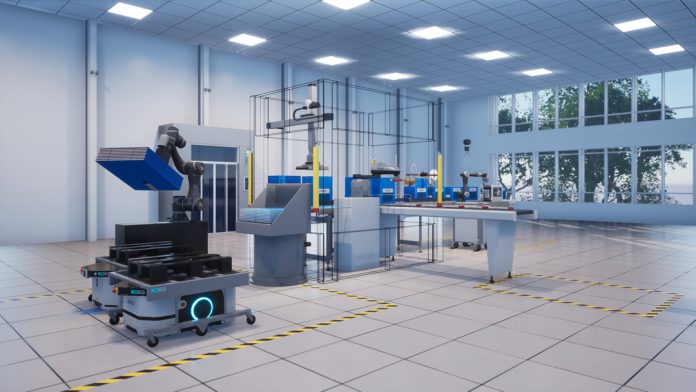John van Hooijdonk breaks down the process of flexible manufacturing
The fast-moving consumer goods market is experiencing a transformative shift, driven by factors such as consumer empowerment, customisation demands, health-conscious preferences, veganism, ethical concerns, and sustainability. We expect that it will undergo more changes in the next decade than it has in the previous 50 years. This necessitates the adaptation of production and supply chains to meet emerging trends. The future of FMCG factories will likely involve smaller, smarter facilities with autonomous movement of goods and interconnected systems.
Machines, whether standalone or interconnected, need to be more flexible than ever before to ensure the timely supply of appropriate materials and packaging. Production has to be more agile, increasingly producing retail-ready items with a high mix-low volume approach with zero recalls. The question is how to realise this with minimal cost and fast ROI?
Workflow in three levels
To achieve the optimal solution with maximum flexibility, it is important to consider various factors. A practical approach, like the one employed by OMRON, focuses on optimising processes to minimise disruptions. This involves breaking down the workflow into three functional levels.
Level 1 – For the machine
Before reaching the production line and machine level, the emphasis needs to be on enabling flexibility in the production line, thanks to just-in-time delivery of consumables, optimising the transport of goods, boxes, and pallets, as well as managing half-products, waste, and unused consumables. The goal is to avoid storing consumables and half-products on the shop floor.

Level 2 – At the machine
At the machine level, the focus shifts to automating material verification and feeding processes, replacing manual feeding activities with automated ones, conducting quality assurance on packaging materials, and ensuring package integrity after packaging.

Level 3 – In the machine
In the machine itself, all functions such as machine control, motion, robotics, sensing, vision, and safety are automatically aligned. This ensures that tasks like filling, capping, tray loading, seaming, sealing, and labelling are executed as quickly as possible, thereby enhancing overall efficiency.

For the machine: Enabling flexibility in the production line
Designing, building, and optimising a process and packaging line requires expertise and experience to ensure maximum benefits from an investment. Enhancing line performance by optimising the flow of goods and consumables on the factory floor and adjoining storage areas is key.
The use of autonomous mobile robots (AMRs), collaborative robots (cobots), and traditional industrial robots is becoming increasingly common in factories. Mobile robots are replacing traditional conveyor systems, aiming to create a flexible and continuous production process that can accommodate customer-specific manufacturing needs while minimising the reliance on rigid and maintenance-heavy conveyors. This shift not only improves agility but also reduces scrap, contamination risks, waste, and losses. Maintaining interconnectivity among production processes is crucial to ensure uninterrupted flow.
Collaborative and flexible transport and transfer solutions, such as those offered by OMRON and its partners, can be tailored to specific production environments. These solutions involve tasks like transferring work-in-progress (WIP) stock between locations or rework areas, guided by fleet management systems. By leveraging expertise and innovative solutions, manufacturers can achieve greater flexibility, optimise production processes, and enhance overall line performance. The focus is on tailoring solutions to meet specific requirements and improve the efficiency of the production environment.
At the machine: Automating material verification and feeding processes
Mastering optimal replenishment is an important element in improving Overall Equipment Effectiveness (OEE), eliminating waiting time, and minimising intermediate stock on the factory floor. This concentrates on package and container loading as well as the efficient output of finished goods. The objective is to ensure timely and direct material feeding without any manual intervention, thus eliminating line starvation and reducing the chances of errors.
To control conveyor systems effectively without causing damage to products, automatic position control of goods on the conveyor is essential. For example, OMRON’s Sysmac control platform offers Smart Conveyor Function Blocks (FBs) dedicated to spacing and positioning products on the conveyor. This feature enables precise control and alignment of goods, optimising conveyor operations without compromising product integrity.
Collaborative robots, or cobots, can significantly improve material feeding processes. These robots can pick up packaging materials like cartons and place them directly onto conveyor belts or into packaging machines. This eliminates the need for manual unloading of consumables and greatly enhances efficiency. By incorporating cobots into operations, manufacturers can ensure the safe and damage-free handling of products, resulting in smooth line throughput, reduced scrap, and prevention of damaged products from entering downstream processes.
Advanced control systems, automation, and collaborative robot technologies can optimise material feeding processes. These solutions help minimise human error, enhance overall line efficiency, and achieve seamless and precise handling of materials. This not only safeguards product quality but also maximises the throughput of a production line.
In the machine: Streamlining machine functions for enhanced efficiency
What happens within the machine? Efficient handling of products is crucial for maintaining throughput and preparing them for downstream processes. Delta-style robots, along with smart conveyor tracking capabilities, are ideal for fast, accurate, repeatable, and efficient handling, such as precise pick and place operations. Software can optimise flow rates and recipe handling, ensuring seamless integration and operation. With one controller that handles motion, vision, safety, and robotics, OMRON provides a comprehensive solution for streamlined machine functionality.
When considering machine throughput, speed is important but not the sole determining factor. By integrating product orientation, sorting/grading, and picking and placing within the machine, valuable time and resources can be saved. This reduces changeover time and enhances overall efficiency.
Seamless transformation and changeover processes rely on the alignment of sensing, control, motion, safety, and robotics. However, as systems become more interwoven, machine settings become more complex. Decentralised robot and PLC programming can lead to issues such as lack of real-time communication between devices and the need for dual programming and debugging. Complex production lines often require independent modification of both PLC and robot programs, followed by recommissioning.
To address these challenges, OMRON offers a more convenient solution that revolves around one controller, one software, and one connection. A modular and scalable architecture is crucial for flexibility and adaptability. OMRON’s Robotic Integrated Controller (RIC) significantly reduces changeover time for the entire production line. The Recipe Manager simplifies the creation of manufacturing recipes and product variants, while visual monitoring facilitates easy modifications. The RIC synchronises automation technology, enabling manufacturers to improve speed, accuracy, and efficiency, simulate entire production lines, simplify maintenance, and reduce time-to-market.
The Benefits
The automation of production processes for flexible manufacturing offers numerous advantages, including:
- Faster product change-over capabilities enable quick adjustments and modifications to production lines, reducing changeover time and optimising performance
- Improved tracking and analysis provide valuable insights for continuous improvement and workflow optimisation.
- Increased employee satisfaction thanks to focus on value-adding tasks and more strategic and creative work
By leveraging the benefits of automated flexibility, companies can achieve greater operational efficiency, employee safety, cost savings, product innovation, and improved competitiveness.
For more information, please visit http://industrial.omron.eu/make-it-flexible
#MakeitFlexibl
John van Hooijdonk is the Industry Marketing Manager for OMRON Europe




